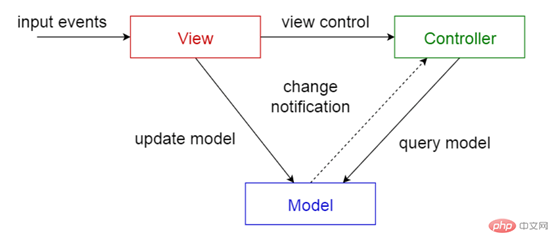MVC原理与container, facade设计模式

一、MVC是一种架构模式,M-模型/V-视图/C-控制器
- 模型(Model):负责存储系统的中心数据。
- 视图(View):将信息显示给用户(可以定义多个视图)。
- 控制器(Controller):处理用户输入的信息。负责从视图读取数据,控制用户输入,并向模型发送数据,是应用程序中处理用户交互的部分。负责管理与用户交互交互控制。
1、MVC实例展示:
实例效果:

实例源码:
<?//模型层:当前页面要显示的数据$pdo = new PDO('mysql:host=localhost;dbname=study','root','123456');$orders = $pdo->query('SELECT `id`,`name`,`pro`,`price` FROM `order` order by id asc LIMIT 8')->fetchAll(PDO::FETCH_ASSOC);// print_r($orders);?><!-- 视图层 --><!DOCTYPE html><html lang="en"><head><meta charset="UTF-8"><meta name="viewport" content="width=device-width, initial-scale=1.0"><title>订单数据显示</title><link rel="stylesheet" href="style.css"></head><body><table width="100%" border="1" cellspacing="0" cellpadding="5"><caption>用户信息表</caption><thead><tr><td>编号</td><td>姓名</td><td>项目</td><td>价格</td><td>操作</td></tr></thead><tbody><?php foreach($orders as $order):?><tr><td><?= $order['id']?></td><td><?= $order['name']?></td><td><?= $order['pro']?></td><td><?= $order['price']?></td><td><button>删除</button><button>编辑</button></td></tr><?php endforeach;?></tbody></table></body></html>
二、公共模型和视图类:
1、Model.php
<?phpnamespace zhangfugen;use PDO;class Model {//获取数据public function getData(){return (new PDO('mysql:host=localhost;dbname=study','root','123456'))->query('SELECT `id`,`name`,`pro`,`price` FROM `order` order by id DESC LIMIT 10')->fetchAll(PDO::FETCH_ASSOC);}}
2、View.php
<?phpnamespace zhangfugen;//视图 : 数据展示class View {public function fetch($data){$table = '<table>';$table.= ' <caption>订单信息表</caption>';$table.= '<tr><th>编号</th><th>名称</th><th>项目</th><th>价格</th></tr>';foreach($data as $user){$table.= '<tr>';$table.=' <td>'.$user['id'].'</td>';$table.=' <td>'.$user['name'].'</td>';$table.=' <td>'.$user['pro'].'</td>';$table.=' <td>'.$user['price'].'</td>';$table.= '</tr>';}$table .= '</table>';return $table;}}echo '<style>table {border-collapse: collapse; border: 1px solid;text-align: center; height: 480px;width: 780px;}caption {font-size: 2rem; margin: 20px 0px;}tr:first-of-type { background-color:lightgreen;}td,th {border: 1px solid; padding:5px}</style>';
三、参数注入在MVC原理应用:

<?php// 参数注入在MVC原理应用:namespace zhangfugen;//加载模型 视图类require 'Model.php';require 'View.php';class Controller{public function index($model,$view){//1. 获取数据$data = $model->getData();//2.模板渲染return $view->fetch($data);}public function edit($model){}}$contr = new Controller;$model = new Model();$view = new View();echo $contr->index($model,$view);
四、实现外部对象在当前类中的共享(复用):
通过构造方法:
<?php// 通过构造方法将实现外部对象在当前类中的共享(复用):namespace zhangfugen;//加载模型 视图类require 'Model.php';require 'View.php';class Controller {private $model;private $view;// 通过构造方法将外部对象初始化,实现了外部依赖注入的对象在类内部的共享/复用public function __construct($model,$view){$this->model = $model;$this->view = $view;}public function index(){//1. 获取数据$data = $this->model->getData();//2.模板渲染return $this->view->fetch($data);}public function edit(){}public function uqdate(){}}// 实例化类:$model = new Model();$view = new View();// 外部对象的注入点放在了魔术方法$contr = new Controller($model,$view);echo $contr->index();
将外部对象放到一个”服务容器”中进行统一管理:
服务容器Container

<?php// 将外部对象放到一个"服务容器"中进行统一管理// 服务容器Containernamespace zhangfugen;//引用基类Closure,是用于代表匿名函数的类use Closure;//加载模型 视图类require 'Model.php';require 'View.php';// 服务容器: 一个自动产生类/对像的工厂class Container {//1. 定义对象容器:protected $instances = [];// 2. 对象容器中添加对象// $abstract 类标识,当前容器数组中的键名/别名// $concrete 要绑定的类, 闭包或者实例,实现方法public function bind($abstract, Closure $concrete){$this->instances[$abstract] = $concrete;}// 3.从对象容器中取出对象, 调用public function make($abstract,$params=[]){return call_user_func_array($this->instances[$abstract],$params);}}$container = new Container;// 将外部对象: Model, View的实例绑定到服务容器中$container->bind('model',function(){return new Model();});$container->bind('view',function(){return new View();});class Controller {// 控制器获取数据,并展示出来public function index(Container $container){//1. 获取数据$data = $container->make('model')->getData();//2.模板渲染return $container->make('view')->fetch($data);}}// 实例化输出$contr = new Controller();echo $contr->index($container);
Facade门面技术静态接管服务容器中对象的访问:

<?php// Facade门面技术静态接管服务容器中对象的访问namespace zhangfugen;//引用基类Closure,是用于代表匿名函数的类use Closure;//加载模型 视图类require 'Model.php';require 'View.php';// <=========================================================================>// 服务容器: 一个自动产生类/对像的工厂// 将外部对象放到一个"服务容器"中进行统一管理class Container {//1. 定义对象容器:protected $instances = [];// 2. 对象容器中添加对象// $abstract 类标识,当前容器数组中的键名/别名// $concrete 要绑定的类, 闭包或者实例,实现方法public function bind($abstract, Closure $concrete){$this->instances[$abstract] = $concrete;}// 3.从对象容器中取出对象, 调用public function make($abstract,$params=[]){return call_user_func_array($this->instances[$abstract],$params);}}$container = new Container;// 将外部对象: Model, View的实例绑定到服务容器中$container->bind('model',function(){return new Model();});$container->bind('view',function(){return new View();});// <==========================================================================>// Facade门面技术静态接管服务容器中对象的访问// 服务容器与工作的控制器之间再添加一个中间层: Facadeclass Facade {protected static $container = null;// 给当前facade类中的$container属性进行赋值,将container注入到当前facade类中public static function initialize(Container $container ){static::$container = $container;}}//模型类 成员的访问静态化:class UserModel extends Facade{public static function getData(){//后期静态绑定return static::$container->make('model')->getData();}}//视图类 成员的访问静态化:class UserView extends Facade{public static function fetch($data){//后期静态绑定return static::$container->make('view')->fetch($data);}}// <==========================================================================>class Controller {//构造方法,初始化facadepublic function __construct(Container $container){Facade::initialize($container);}//使用门面技术facade方式 访问成员public function index(){//1. 获取数据$data = UserModel::getData();//2.模板渲染return UserView::fetch($data);}}// 实例化输出$contr = new Controller($container);echo $contr->index();

